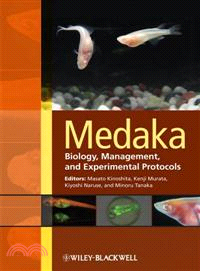Medaka ─ Biology, Management, and Experimental Protocols.
商品資訊
定價
:NT$ 8713 元優惠價
:90 折 7842 元
若需訂購本書,請電洽客服 02-25006600[分機130、131]。
相關商品
商品簡介
作者簡介
目次
商品簡介
Medaka: Biology, Management, and Experimental Protocols, written by experienced researchers and reviewed by international leaders in the medaka field will provide details on how to set up and maintain medaka colonies in animal facilities, how to troubleshoot systems, how to handle the fish when applied to experimental methods, and most importantly it will introduce the researcher to cutting edge research in basic and applied biology using medaka as a model animal. The book will include well-written descriptions of experimental methods and protocols designed to educate the reader how to understand and handle medaka effectively.
Medaka: Biology, Management, and Experimental Protocols will serve as the definitive reference on the species providing essential information on medaka biology, genetics, and genomics, practical guidance to maintenance of fish stocks, and valuable experimental protocols all in a single volume. This book will be a must have addition to the library of fish researchers and those using medaka as a model organism within their laboratories.
Medaka: Biology, Management, and Experimental Protocols will serve as the definitive reference on the species providing essential information on medaka biology, genetics, and genomics, practical guidance to maintenance of fish stocks, and valuable experimental protocols all in a single volume. This book will be a must have addition to the library of fish researchers and those using medaka as a model organism within their laboratories.
作者簡介
Masato Kinoshita is an Assistant Professor in the Division of Applied Biosciences at Kyoto University, Japan.
Kenji Murata is an Assistant Research Biochemist in the Department of Animal Science at the University of California-Davis, USA.
Kiyoshi Naruse is an Associate Professor at the National Institute for Basic Biology, Japan.
Minoru Tanaka is an Associate Professor at the National Institute for Basic Biology, Japan.
Kenji Murata is an Assistant Research Biochemist in the Department of Animal Science at the University of California-Davis, USA.
Kiyoshi Naruse is an Associate Professor at the National Institute for Basic Biology, Japan.
Minoru Tanaka is an Associate Professor at the National Institute for Basic Biology, Japan.
目次
Chapter 1: HIstory and Features of Medaka.
1.1. HISTORY.
1.2. phylogeny.
1.2.1. Phylogeny and distribution of medaka and relatives.
1.2.2. Genetic diversity of medaka.
1.3. Advantage of medaka as a model fish.
1.3.1. Advantageous features in general.
1.3.2. Color mutants.
1.3.3. Wild strains.
1.3.4. Inbred strains.
COLUMN 1.1. For those who cannot decide which medaka to use.
COLUMN 1.2. Variation among strains.
1.3.5. Differences from zebrafish.
Chapter 2: MEDAKA MANAGEMENT.
2.1. HOW TO OBTAIN MEDAKA.
2.1.1 Obtain medaka from researchers who are culturing medaka.
2.1.2 Contact the National Bio-Resource Project (medaka) in Japan.
2.1.3. Purchase medaka from commercial vendors (aquarium shops).
2.1.4. Catching medaka from the wild.
2.2. REARING MEDAKA.
2.2.1. Breeding program.
2.2.2. Recirculating system (mid-scale system).
COLUMN 2.1 Soft water is suitable for medaka breeding.
2.2.3. Large-scale breeding.
2.2.4. Rearing without water circulation (small-scale system).
2.2.5.Outdoor breeding.
2.3. FEEDING.
2.3.1. Feed for adult fish and larvae.
2.3.2. Feeding schedule.
2.3.3. Feed.
2.4. DISEASES.
2.4.1. Tail rot disease.
2.4.2. Matsukasa disease.
2.4.3. Trichodina.
2.4.4. Water mold.
2.4.5. White spot disease.
2.4.6. Water mites.
2.4.7. Gyrodactylus.
2.5. GOODS FOR MEDAKA.
Chapter 3: REPRODUCTION OF MEDAKA.
3.1. SEX DETERMINATION.
3.1.1 Sex determination in medaka.
3.1.2. Sex determination in the genus Oryzias.
3.1.3. Spontaneous sex reversals in medaka.
3.2. HORMONAL CONTROL OF GONADAL DEVELOPMENT.
3.2.1. Brain-pituitary-gonadal axis.
3.2.2. Oocyte growth and maturation.
3.2.3. Spermatocyte growth and maturation.
3.3. OOGENESIS AND SPERMATOGENESIS.
3.3.1. Oogenesis.
3.3.2. Spermatogenesis.
3.4. EGG ENVELOPE (CHORION).
3.4.1. Morphology and biochemical characters of the medaka egg envelope.
3.4.2. Origin of the egg envelope in medaka fish.
3.4.3. Gene structure of egg envelope glycoproteins in medaka.
3.4.4. Molecular mechanisms of liver-specific expression of Choriogenins’ Genes.
3.4.5. Assembly of the Choriogenins into the egg envelope in the ovary.
3.4.6. Egg envelope glycoproteins as the substrates for the hatching enzyme.
3.4.7. Conclusion.
3.5. NECESSARY CONDITIONS FOR SPAWNING.
3.6. REPRODUCTIVE BEHAVIOR.
3.7. MATING.
3.8. EMBRYO COLLECTION.
3.8.1. Embryo collection directly from females.
3.8.2. Embryo collection from the bottom of the tank.
3.9. EMBRYONIC CULTURE.
3.9.1. Cleaning.
3.9.2. Incubation.
3.10. LARVAL CULTURE.
3.11. GENERATION OF SEX-REVERSED MEDAKA.
3.11.1. Treatment with androgen to generate XX males.
3.11.2. Treatment with estrogen to generate XY females.
3.11.3. High temperature treatment to generate XX males.
COLUMN 3.1. Interstrain variation in reproductive performance.
Chapter 4: STRAIN PRESERVATION AND THE RELATED TECHNIQUES.
4.1. SHIPPING.
4.1.1. Scheduling.
4.1.2. Sorting of eggs or fish.
4.1.3. Procedures for packaging.
4.1.4. Transgenic medaka.
4.1.5. MTA (Material Transfer Agreement).
4.2. QUARANTINE AND PASTEURIZATION.
4.2.1. Materials for Pasteurization of eggs/embryos.
4.2.2. Procedure.
4.3. CRYOPRESERVATION OF MEDAKA SPERM.
4.3.1. Overview.
4.3.2. The procedure for cryopreservation.
4.3.3. Materials.
4.3.4. Solutions.
4.3.5. Procedures.
4.4. ARTIFICIAL INSEMINATION USING FROZEN MEDAKA-SPERM.
4.4.1. Overview.
4.4.2. Solutions.
4.4.3. Materials.
4.4.4. Procedures.
COLUMN 4.1. Infertile mating method for collecting unfertilized eggs.
Chapter 5: LOOKING AT ADULT MEDAKA.
5.1. GENERAL MORPHOLOGY.
5.1.1. Secondary sexual characters.
5.1.2. Body color.
5.2. ANATOMY AND HISTOLOGY.
5.2.1. Observations of internal organs.
5.2.2. Horizontal and sagittal sections of juvenile medaka.
5.2.3. Nervous system.
5.2.4. Endocrine system.
5.2.5. Gonads.
5.2.6. Kidney.
COLUMN 5.1. How to make sections of a mature ovary for histological analysis.
Chapter 6: LOOKING AT MEDAKA EMBRYOS.
6.1. DEVELOPMENT OF VARIOUS TISSUES AND ORGANS.
6.1.1. Developmental stages.
6.1.2. Brain.
6.1.3. Hatching gland.
6.1.4. Eye development.
6.1.5. Branchial arch and jaws.
6.1.6. Vasculature.
6.1.7. Blood cells (hematopoiesis).
6.1.8. Heart.
6.1.9. Kidney.
6.1.10. Thymus.
6.1.11. Gut and liver.
6.1.12. Bones.
COLUMN 6.1. Key words in bone formation.
6.1.13 Fins.
6.1.14. Gonads.
6.2. MEDAKA EGG ENVELOPE AND HATCHING ENZYME.
6.2.1. Overview.
6.2.2. Preparation of a hatching enzyme solution from hatching liquid.
6.2.3. Simple method for preparing hatching enzyme solution.
6.2.4. Solubilization of the egg envelope using hatching enzyme.
COLUMN 6.2. Easy method for preparation of a small amount of hatching enzyme solution.
6.3. OBSERVATION OF EMBRYOS (Embedding Embryos).
6.3.1. Anesthesia of embryos using MS-222.
6.3.2. Observation of embryos (mounting).
6.3.2.1. Living embryos.
6.3.2.2. Processed Embryos.
6.4. WHOLE MOUNT IN SITU HYBRIDIZATION.
6.4.1. Fixation and Storage.
6.4.2. Rehydration, proteinase K treatment and post-fixation at RT.
6.4.3. Hybridization and washing.
6.4.4. Immunoreaction and washing antibodies.
6.4.5. Staining.
6.5. EMBEDDING IN A PLASTIC RESIN (Technovit 7100).
6.5.1. Agarose mounting.
6.5.2. Dehydration and infiltration.
6.5.3. Polymerization.
COLUMN 6.3. Pigment cells.
COLUMN 6.4. Kupffer’s vesicle.
Chapter 7: TRANSGENESIS.
7.1. MICROINJECTION TECHNIQUE FOR MEDAKA EGGS.
7.1.1. Equipment required.
COLUMN 7.1. Microinjection into nuclei.
7.2. DNA microinjection.
7.2.1. DNA microinjection for transgenesis and transient expression.
7.2.2. DNA construction for transgenesis.
COLUMN 7.2. Toxicity of DNA.
COLUMN 7.3. The form of DNA for transgenesis.
7.3. RNA MICROINJECTION.
COLUMN 7.4. Importance of 3’-UTR.
7.4. GENE KNOCKDOWN TECHNOLOGY.
7.4.1. Morpholinos.
7.4.2. gripNAs.
Chapter 8: TOXICOLOGY.
8.1. STATUS OF MEDAKA IN TOXICOLOGY.
8.2. FISH CULTURE FOR TOXICOLOGY.
8.2.1. Preparation and acclimation of fish.
8.2.2. How to expose to chemicals.
8.3. STANDARDIZED TOXICITY TESTINGS.
8.3.1. International standardization for toxicity tests.
8.3.2. Acute Toxicity Test (OECD TG203).
8.3.3. Early-life stage toxicity test (OECD TG210).
8.4. APPLIED TOXICITY TESTS FOR ENDOCRINE DISRUPTERS.
8.4.1 Screening assays using medaka.
8.4.2 Fish full lifecycle testing (FFLC) using medaka.
8.4.3. Sensitive period to estrogen substances in early life stages.
8.5. VITELLOGENIN AS AN ENVIRONMENTAL ENDOCRINE DISRUPTING CHEMICAL EXPOSURE.
8.5.1. Features of VTG.
8.5.2. Vitellogenin measurement.
8.5.3. Summary and comments.
8.6. NEW TECHNIQUES AND OTHER STUDIES.
COLUMN 8. Application of medaka and Olyzias Sp. in seawater.
Chapter 9: BIOINFORMATICS.
9.1. Medaka genome project and genome sequence database.
9.1.1. Genome database.
9.1.2. Polymorphism between the Southern and Northern Japanese populations.
COLUMN 9.1. How to get BAC/Fosmid clones harboring the target gene..
9.2. DATABASE FOR transcribed sequences.
9.2.1. EST database.
9.2.2. Developmental Expression database.
9.3. Positional Cloning of THE Causal gene in mutants.
9.3.1 Mapping mutants using SSLP and RFLP markers.
COLUMN 9.2. Construction of Fosmid library.
Chapter 10: ADVANCED TECHNIQUES.
10.1. CELL CULTURE FROM MEDAKA EMBRYO.
10.1.1. Flow chart of primary cell culture from medaka embryo.
10.1.2. Equipment and materials.
10.1.3. Protocol.
10.1.4. Notes.
10.2. IN VITRO SPERMATOGENESIS FROM PRIMARY SPERMATOCYTES.
10.2.1. Flow chart.
10.2.2. Required equipment and materials for primary culture of primary spermatocytes.
10.2.3. Protocol.
10.3. SINGLE CELL LABELING.
10.3.1. Flow Chart.
10.3.2. Required Equipment and Materials.
10.3.3. Protocol.
10.3.4. Example of cell labeling and tracing.
10.4. IMAGING OF LIVING EMBRYOS.
10.4.1. Flow chart.
10.4.2. Fluorescent labeling.
10.4.3. Sample preparation.
10.4.4. Recording setup.
10.4.5. Data analysis.
10.4.6. Time-lapse imaging of primordial germ cell migration.
10.4.7. Conclusion.
10.5. TRANSPLANTATION.
10.5.1. Cell Transplantation in Embryo.
10.5.2. Scale.
10.6. NUCLEAR TRANSPLANTATION.
10.6.1. Equipment and materials.
10.6.2. Flow chart of the method.
10.6.3. Perspectives.
10.7. MUTAGENESIS.
10.7.1. Benefits of using medaka.
10.7.2. Mutagens that have been used for medaka.
10.7.3. Mutagenesis screen using ENU.
10.8. TILLING (Gene Knockout).
10.8.1. The Outline of the TILLING Method.
10.8.2. An example of screening and quality of our library.
10.8.3. About SNPs.
10.8.4. How to obtain a Medaka TILLING library.
10.9. Cell TRACE EXPERIMENT WITH A CAGED FLUORESCENT DYE DURING MEDAKA GASTRULATION.
10.9.1. Flow chart.
10.9.2. Equipment and materials.
10.9.3. Protocol.
10.9.4. Notes.
Appendix 1. Guidelines on using medaka in experiments.
Appendix 2. Internet websites related to medaka research.
Appendix 3. Solutions.
Appendix 4 Inbred strains, closed colonies, and mutant strains.
1.1. HISTORY.
1.2. phylogeny.
1.2.1. Phylogeny and distribution of medaka and relatives.
1.2.2. Genetic diversity of medaka.
1.3. Advantage of medaka as a model fish.
1.3.1. Advantageous features in general.
1.3.2. Color mutants.
1.3.3. Wild strains.
1.3.4. Inbred strains.
COLUMN 1.1. For those who cannot decide which medaka to use.
COLUMN 1.2. Variation among strains.
1.3.5. Differences from zebrafish.
Chapter 2: MEDAKA MANAGEMENT.
2.1. HOW TO OBTAIN MEDAKA.
2.1.1 Obtain medaka from researchers who are culturing medaka.
2.1.2 Contact the National Bio-Resource Project (medaka) in Japan.
2.1.3. Purchase medaka from commercial vendors (aquarium shops).
2.1.4. Catching medaka from the wild.
2.2. REARING MEDAKA.
2.2.1. Breeding program.
2.2.2. Recirculating system (mid-scale system).
COLUMN 2.1 Soft water is suitable for medaka breeding.
2.2.3. Large-scale breeding.
2.2.4. Rearing without water circulation (small-scale system).
2.2.5.Outdoor breeding.
2.3. FEEDING.
2.3.1. Feed for adult fish and larvae.
2.3.2. Feeding schedule.
2.3.3. Feed.
2.4. DISEASES.
2.4.1. Tail rot disease.
2.4.2. Matsukasa disease.
2.4.3. Trichodina.
2.4.4. Water mold.
2.4.5. White spot disease.
2.4.6. Water mites.
2.4.7. Gyrodactylus.
2.5. GOODS FOR MEDAKA.
Chapter 3: REPRODUCTION OF MEDAKA.
3.1. SEX DETERMINATION.
3.1.1 Sex determination in medaka.
3.1.2. Sex determination in the genus Oryzias.
3.1.3. Spontaneous sex reversals in medaka.
3.2. HORMONAL CONTROL OF GONADAL DEVELOPMENT.
3.2.1. Brain-pituitary-gonadal axis.
3.2.2. Oocyte growth and maturation.
3.2.3. Spermatocyte growth and maturation.
3.3. OOGENESIS AND SPERMATOGENESIS.
3.3.1. Oogenesis.
3.3.2. Spermatogenesis.
3.4. EGG ENVELOPE (CHORION).
3.4.1. Morphology and biochemical characters of the medaka egg envelope.
3.4.2. Origin of the egg envelope in medaka fish.
3.4.3. Gene structure of egg envelope glycoproteins in medaka.
3.4.4. Molecular mechanisms of liver-specific expression of Choriogenins’ Genes.
3.4.5. Assembly of the Choriogenins into the egg envelope in the ovary.
3.4.6. Egg envelope glycoproteins as the substrates for the hatching enzyme.
3.4.7. Conclusion.
3.5. NECESSARY CONDITIONS FOR SPAWNING.
3.6. REPRODUCTIVE BEHAVIOR.
3.7. MATING.
3.8. EMBRYO COLLECTION.
3.8.1. Embryo collection directly from females.
3.8.2. Embryo collection from the bottom of the tank.
3.9. EMBRYONIC CULTURE.
3.9.1. Cleaning.
3.9.2. Incubation.
3.10. LARVAL CULTURE.
3.11. GENERATION OF SEX-REVERSED MEDAKA.
3.11.1. Treatment with androgen to generate XX males.
3.11.2. Treatment with estrogen to generate XY females.
3.11.3. High temperature treatment to generate XX males.
COLUMN 3.1. Interstrain variation in reproductive performance.
Chapter 4: STRAIN PRESERVATION AND THE RELATED TECHNIQUES.
4.1. SHIPPING.
4.1.1. Scheduling.
4.1.2. Sorting of eggs or fish.
4.1.3. Procedures for packaging.
4.1.4. Transgenic medaka.
4.1.5. MTA (Material Transfer Agreement).
4.2. QUARANTINE AND PASTEURIZATION.
4.2.1. Materials for Pasteurization of eggs/embryos.
4.2.2. Procedure.
4.3. CRYOPRESERVATION OF MEDAKA SPERM.
4.3.1. Overview.
4.3.2. The procedure for cryopreservation.
4.3.3. Materials.
4.3.4. Solutions.
4.3.5. Procedures.
4.4. ARTIFICIAL INSEMINATION USING FROZEN MEDAKA-SPERM.
4.4.1. Overview.
4.4.2. Solutions.
4.4.3. Materials.
4.4.4. Procedures.
COLUMN 4.1. Infertile mating method for collecting unfertilized eggs.
Chapter 5: LOOKING AT ADULT MEDAKA.
5.1. GENERAL MORPHOLOGY.
5.1.1. Secondary sexual characters.
5.1.2. Body color.
5.2. ANATOMY AND HISTOLOGY.
5.2.1. Observations of internal organs.
5.2.2. Horizontal and sagittal sections of juvenile medaka.
5.2.3. Nervous system.
5.2.4. Endocrine system.
5.2.5. Gonads.
5.2.6. Kidney.
COLUMN 5.1. How to make sections of a mature ovary for histological analysis.
Chapter 6: LOOKING AT MEDAKA EMBRYOS.
6.1. DEVELOPMENT OF VARIOUS TISSUES AND ORGANS.
6.1.1. Developmental stages.
6.1.2. Brain.
6.1.3. Hatching gland.
6.1.4. Eye development.
6.1.5. Branchial arch and jaws.
6.1.6. Vasculature.
6.1.7. Blood cells (hematopoiesis).
6.1.8. Heart.
6.1.9. Kidney.
6.1.10. Thymus.
6.1.11. Gut and liver.
6.1.12. Bones.
COLUMN 6.1. Key words in bone formation.
6.1.13 Fins.
6.1.14. Gonads.
6.2. MEDAKA EGG ENVELOPE AND HATCHING ENZYME.
6.2.1. Overview.
6.2.2. Preparation of a hatching enzyme solution from hatching liquid.
6.2.3. Simple method for preparing hatching enzyme solution.
6.2.4. Solubilization of the egg envelope using hatching enzyme.
COLUMN 6.2. Easy method for preparation of a small amount of hatching enzyme solution.
6.3. OBSERVATION OF EMBRYOS (Embedding Embryos).
6.3.1. Anesthesia of embryos using MS-222.
6.3.2. Observation of embryos (mounting).
6.3.2.1. Living embryos.
6.3.2.2. Processed Embryos.
6.4. WHOLE MOUNT IN SITU HYBRIDIZATION.
6.4.1. Fixation and Storage.
6.4.2. Rehydration, proteinase K treatment and post-fixation at RT.
6.4.3. Hybridization and washing.
6.4.4. Immunoreaction and washing antibodies.
6.4.5. Staining.
6.5. EMBEDDING IN A PLASTIC RESIN (Technovit 7100).
6.5.1. Agarose mounting.
6.5.2. Dehydration and infiltration.
6.5.3. Polymerization.
COLUMN 6.3. Pigment cells.
COLUMN 6.4. Kupffer’s vesicle.
Chapter 7: TRANSGENESIS.
7.1. MICROINJECTION TECHNIQUE FOR MEDAKA EGGS.
7.1.1. Equipment required.
COLUMN 7.1. Microinjection into nuclei.
7.2. DNA microinjection.
7.2.1. DNA microinjection for transgenesis and transient expression.
7.2.2. DNA construction for transgenesis.
COLUMN 7.2. Toxicity of DNA.
COLUMN 7.3. The form of DNA for transgenesis.
7.3. RNA MICROINJECTION.
COLUMN 7.4. Importance of 3’-UTR.
7.4. GENE KNOCKDOWN TECHNOLOGY.
7.4.1. Morpholinos.
7.4.2. gripNAs.
Chapter 8: TOXICOLOGY.
8.1. STATUS OF MEDAKA IN TOXICOLOGY.
8.2. FISH CULTURE FOR TOXICOLOGY.
8.2.1. Preparation and acclimation of fish.
8.2.2. How to expose to chemicals.
8.3. STANDARDIZED TOXICITY TESTINGS.
8.3.1. International standardization for toxicity tests.
8.3.2. Acute Toxicity Test (OECD TG203).
8.3.3. Early-life stage toxicity test (OECD TG210).
8.4. APPLIED TOXICITY TESTS FOR ENDOCRINE DISRUPTERS.
8.4.1 Screening assays using medaka.
8.4.2 Fish full lifecycle testing (FFLC) using medaka.
8.4.3. Sensitive period to estrogen substances in early life stages.
8.5. VITELLOGENIN AS AN ENVIRONMENTAL ENDOCRINE DISRUPTING CHEMICAL EXPOSURE.
8.5.1. Features of VTG.
8.5.2. Vitellogenin measurement.
8.5.3. Summary and comments.
8.6. NEW TECHNIQUES AND OTHER STUDIES.
COLUMN 8. Application of medaka and Olyzias Sp. in seawater.
Chapter 9: BIOINFORMATICS.
9.1. Medaka genome project and genome sequence database.
9.1.1. Genome database.
9.1.2. Polymorphism between the Southern and Northern Japanese populations.
COLUMN 9.1. How to get BAC/Fosmid clones harboring the target gene..
9.2. DATABASE FOR transcribed sequences.
9.2.1. EST database.
9.2.2. Developmental Expression database.
9.3. Positional Cloning of THE Causal gene in mutants.
9.3.1 Mapping mutants using SSLP and RFLP markers.
COLUMN 9.2. Construction of Fosmid library.
Chapter 10: ADVANCED TECHNIQUES.
10.1. CELL CULTURE FROM MEDAKA EMBRYO.
10.1.1. Flow chart of primary cell culture from medaka embryo.
10.1.2. Equipment and materials.
10.1.3. Protocol.
10.1.4. Notes.
10.2. IN VITRO SPERMATOGENESIS FROM PRIMARY SPERMATOCYTES.
10.2.1. Flow chart.
10.2.2. Required equipment and materials for primary culture of primary spermatocytes.
10.2.3. Protocol.
10.3. SINGLE CELL LABELING.
10.3.1. Flow Chart.
10.3.2. Required Equipment and Materials.
10.3.3. Protocol.
10.3.4. Example of cell labeling and tracing.
10.4. IMAGING OF LIVING EMBRYOS.
10.4.1. Flow chart.
10.4.2. Fluorescent labeling.
10.4.3. Sample preparation.
10.4.4. Recording setup.
10.4.5. Data analysis.
10.4.6. Time-lapse imaging of primordial germ cell migration.
10.4.7. Conclusion.
10.5. TRANSPLANTATION.
10.5.1. Cell Transplantation in Embryo.
10.5.2. Scale.
10.6. NUCLEAR TRANSPLANTATION.
10.6.1. Equipment and materials.
10.6.2. Flow chart of the method.
10.6.3. Perspectives.
10.7. MUTAGENESIS.
10.7.1. Benefits of using medaka.
10.7.2. Mutagens that have been used for medaka.
10.7.3. Mutagenesis screen using ENU.
10.8. TILLING (Gene Knockout).
10.8.1. The Outline of the TILLING Method.
10.8.2. An example of screening and quality of our library.
10.8.3. About SNPs.
10.8.4. How to obtain a Medaka TILLING library.
10.9. Cell TRACE EXPERIMENT WITH A CAGED FLUORESCENT DYE DURING MEDAKA GASTRULATION.
10.9.1. Flow chart.
10.9.2. Equipment and materials.
10.9.3. Protocol.
10.9.4. Notes.
Appendix 1. Guidelines on using medaka in experiments.
Appendix 2. Internet websites related to medaka research.
Appendix 3. Solutions.
Appendix 4 Inbred strains, closed colonies, and mutant strains.
主題書展
更多
主題書展
更多書展本週66折
您曾經瀏覽過的商品
購物須知
外文書商品之書封,為出版社提供之樣本。實際出貨商品,以出版社所提供之現有版本為主。部份書籍,因出版社供應狀況特殊,匯率將依實際狀況做調整。
無庫存之商品,在您完成訂單程序之後,將以空運的方式為你下單調貨。為了縮短等待的時間,建議您將外文書與其他商品分開下單,以獲得最快的取貨速度,平均調貨時間為1~2個月。
為了保護您的權益,「三民網路書店」提供會員七日商品鑑賞期(收到商品為起始日)。
若要辦理退貨,請在商品鑑賞期內寄回,且商品必須是全新狀態與完整包裝(商品、附件、發票、隨貨贈品等)否則恕不接受退貨。
























